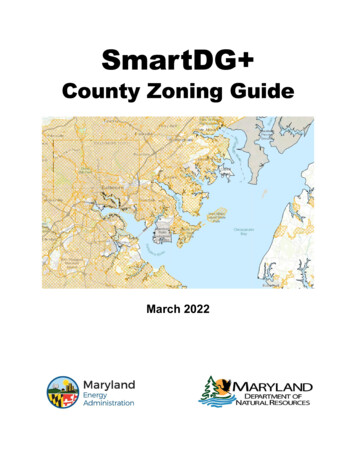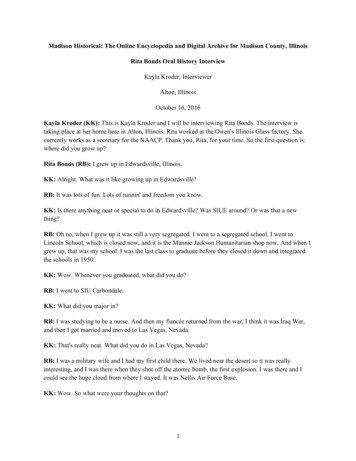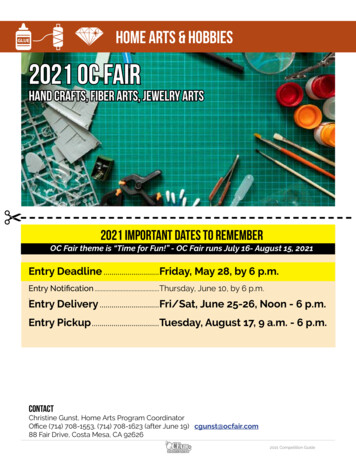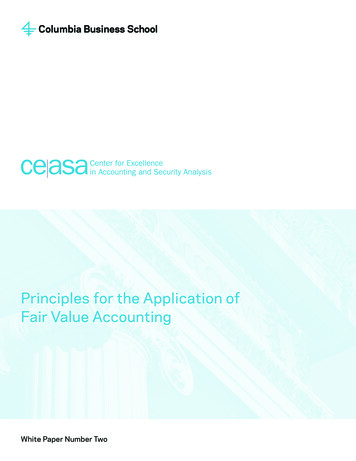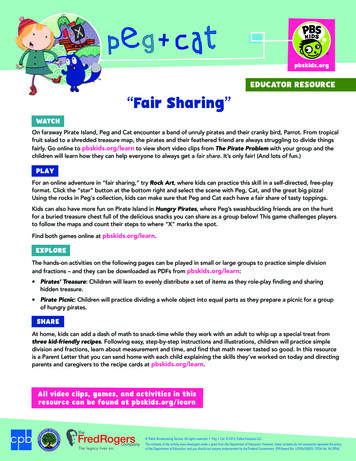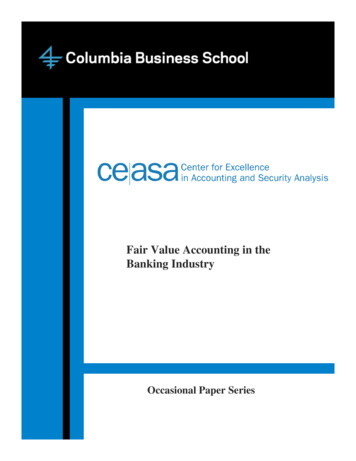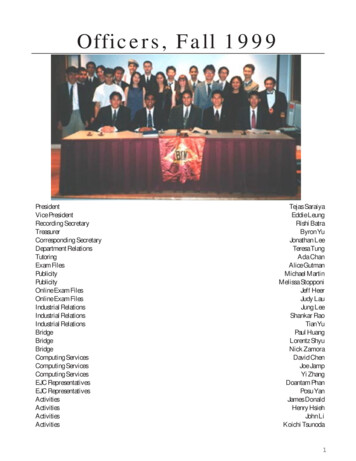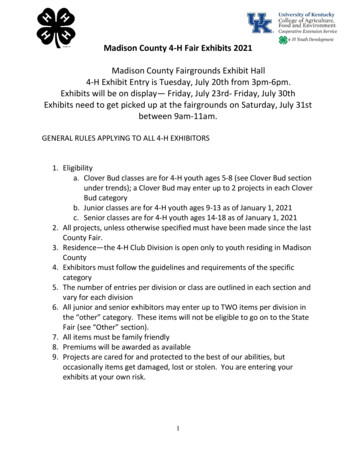
Transcription
Madison County 4-H Fair Exhibits 2021Madison County Fairgrounds Exhibit Hall4-H Exhibit Entry is Tuesday, July 20th from 3pm-6pm.Exhibits will be on display— Friday, July 23rd- Friday, July 30thExhibits need to get picked up at the fairgrounds on Saturday, July 31stbetween 9am-11am.GENERAL RULES APPLYING TO ALL 4-H EXHIBITORS1. Eligibilitya. Clover Bud classes are for 4-H youth ages 5-8 (see Clover Bud sectionunder trends); a Clover Bud may enter up to 2 projects in each CloverBud categoryb. Junior classes are for 4-H youth ages 9-13 as of January 1, 2021c. Senior classes are for 4-H youth ages 14-18 as of January 1, 20212. All projects, unless otherwise specified must have been made since the lastCounty Fair.3. Residence—the 4-H Club Division is open only to youth residing in MadisonCounty4. Exhibitors must follow the guidelines and requirements of the specificcategory5. The number of entries per division or class are outlined in each section andvary for each division6. All junior and senior exhibitors may enter up to TWO items per division inthe “other” category. These items will not be eligible to go on to the StateFair (see “Other” section).7. All items must be family friendly8. Premiums will be awarded as available9. Projects are cared for and protected to the best of our abilities, butoccasionally items get damaged, lost or stolen. You are entering yourexhibits at your own risk.1
IndexArts & Crafts – Division 6029Page3Educational 4-H Dog Project Posters – Division 6011.4Page10Electric – Division 6021Page11Geology – Division 6028Page13Home Environment – Division 6039Page15Needlework – Division 6033Page22Photography – Division 6030Page28Horticultural Photography ExhibitionsPage33Sewing – Division 6032Page33Kentucky 4-H Trends – Division 6042Page40Cloverbud Projects and Other CategoryPage42Entomology/Honey – Division 6026Page424-H Forestry – Division 6027Page474-H Horticulture & Plant Science – Division 6015Page494-H Wood Science – Division 6025Page514-H Consumer & Financial Education – Division 6040Page 524-H Tobacco ExhibitPage564-H Crops – Division 6018Page582
DIVISION 6029 – 4-H ARTS & CRAFTS1)2)3)4)5)Seniors must submit an artist statement label card. This card can be found on the statefair agent resource page. Information on writing an artist statement may be found class/more/statement.htmEach Exhibitor may enter only two (2) classes per sections A & B per year, and one (1)per section C per year.All items must have been made since the last County Fair.Exhibits will be disqualified if:a. Pictures or other hanging items do not have an attached hanger (wire hangers mustbe secure and attached to the frame for paintings and drawings only). No wire hookstaped to back. All hangers must support the weight of item. Pictures should be ready forhanging. May include frame or securely attached hanger (canvas).b. Pictures are not mounted on firm mat, not foam core and/or framed with attachedhanger. No poster board allowed.c. Seniors do not have an artist statement.d. If subject matter is not “family friendly” in context.Small items, which are easily separated or destroyed, may be placed in small plasticbags. For items with more than one piece, a description on the back of the ID card issuggested with number of pieces, color, description, etc.SECTION A: Portfolio PathwaysPainting727a Junior Acrylic: (pg.12) Using acrylic paint to create a painting.727b Senior Acrylic: (pg.12) same as Junior.728a Junior Water Color: (pg.14) Using watercolors and a variety of techniques to complete apainting on watercolor paper.728b Senior Water Color: (pg.14) same as Junior.729a Junior Abstract: (pg.18) Using acrylic paints experiment with abstract designs tocomplete a painting.729b Senior Abstract: (pg.18) same as Junior730a Junior Sand Painting: (pg.20) On an 8”x10” x1/4” sanded plywood or particle board.Explore painting with colored sand mixed with glue.730b Senior Sand Painting: (pg.20) same as Junior.3
731a Junior Self Portrait: (pg.22) Using a medium of your choice. Complete a self- portraitusing any drawing or painting technique.731b Senior Self Portrait: (pg.22) same as Junior.732a Junior Human Action: (pg.24) Using acrylic or watercolor paints, capture human actionthrough the use of vivid colors, lines, and texture when painting.732b Senior Human Action: (pg.24) same as Junior.733a Junior Oil Painting: (pg.26) Using oils on canvas or canvas board. Experiment withdifferent techniques of laying oil to canvas to create a finished painting.733b Senior Oil Painting: (pg.26) same as Junior.734a Junior Oil Pastel: Using Oil pastels on canvas or canvas board, create a finished work ofart.734b Senior Oil Pastel: same as Junior.Printing735a Junior Intaglio Collagraph Print: (pg.38) On 8 ½” x 11” paper. Create a collagraph blockat least 6” wide and create any color print using intaglio printing method.735b Senior Intaglio Collagraph print: (pg.38) same as Junior.736a Junior Blueprint Paper Print: (pg.40) On blueprint paper create a sun print; at least 5 ½ x8 ½ in. using cyanotype or Light or sun sensitive paper.736bSenior Blueprint Paper Print: (pg.40) same as Junior.737aJunior Etched Plexiglas: (pg. 42) Create an original print using an etched Plexiglas plate.The print should be at least 5 ½”x 81/2” in. Plexiglas etching uses the intaglio method ofprinting.737b Senior Etched Plexiglas: (pg.42) same as Junior.738a Junior Wax Resist Print: (pg.44) Create intricate designs for printing using a wax resistmethod.738b Senior Wax Resist Print: (pg. 44) same as Junior.4
739a Junior Tire Stamp Print: (pg.46) Cut pieces of inner tube tire, glue it onto a wood block,and print using a stamp pad.739b Senior Tire Stamp Print: (pg.46) same as Junior.740a Junior Linoleum Print: (pg.48) Create linoleum print using linoleum block on paper.740b Senior Linoleum Print: (pg.48) same as Junior741a Junior Hand Drawn Negative Photograph: (pg.51) You will draw a negative on frostedacetate, then print onto photographic paper (8”x10” in.) as a positive, using aphotographic process.741b Senior Hand Drawn Negative Photograph: (pg.51) same as Junior.Graphic Design743a Junior 5 Color Design: (pg.62-63) Create (2) two 8”x 10”in. landscapes. 5 color designsare identical except for (1) one color. Change (1) one color to create a second design.Use paint, paper or computer graphics program. Mount on a matt board.743b Senior 5 Color Design: (pg.62-63) same as Junior744a Junior Computer Drawing: (pg.70) Explore the use of computer tools and techniques todoodle, draw and replicate images. Print out each design showing the use of varioustools.744b Senior Computer Drawing: (pg.70) same as Junior.Section B: Sketchbook CrossroadsDrawing745a Junior Contour Drawing: (pg.12) Draw objects using the contour drawing method.745b Senior Contour Drawing: (pg.12) same as Junior746a Junior Two Point Perspective: (pg.16) On sketch paper, draw a two point perspectivethat has a point at each end of a horizontal segment.746b Senior Two Point Perspective: (pg.16) same as Junior.747a Junior Circular Shape Object: (pg.18) Draw a subject to fit a circular shape.747b Senior Circular Shape Object: (pg.18) same as Junior.5
748a Junior Color or Black Pencil: (pg.20) Draw with colored pencils or black pencils.748b Senior Color or Black Pencil: (pg.20) same as Junior.749a Junior Pen and Ink: (pg.22) Sketch animals or other objects using pen and ink.749b Senior Pen and Ink: (pg.22) same as Junior750a Junior Calligraphy: (pg.24) On 8 ½ by 11 paper, rewrite a quote, poem or pledge usingCalligraphy. Make sure to include the author on the piece.750b Senior Calligraphy: (pg.24) Same as Junior751a Junior Cartooning: (pg.27) Cartooning is a simple process of making line drawings showsequential motion. Create your own cartoon character showing motion. Must create atleast three blocks.751b Senior Cartooning: (pg.27) same as Junior.Fiber Arts752a Junior Felted Wool Applique Mat: (pg.31) Felt wool to create a design. Applique designto a felted wool mat. Max size of mat 18” x 24” in. Use 100% wool to felt.752b Senior Felted Wool Applique Mat: (pg.31) same as Junior.753a Junior Cotton Linter Bowl: (pg.34) Experiment with cotton linter using molds andshaping the linter to form bowls. Enhance the cotton with colored pencils, threads, floss,dried flowers to make a unique creation.753b Senior Cotton Linter Bowl: (pg.34) same as Junior.754a Junior Batik Fabric: (pg.37) Using natural fiber fabric. Create a unique fiber artwork usingdyes and the wax resist method.754b Senior Batik Fabric: (pg.37) same as Junior.755a Junior Lap Loom Woven Place Mat: (pg.40) Set up a lap Loom. Using several colors ortypes of yarn create a woven placemat.755b Senior Lap Loom Woven Place Mat: (pg.40) same as Junior6
756a Junior Inkle Loom Basket: (pg.44) Weave 4-6 stripes that are identical. Sculpt a basketout of several woven strips by stitching them together in a spiral. Manipulate the stripsto form the bottom of the basket.756b Senior Inkle Loom Basket: (pg.44) same as Junior.Sculpting757a Junior Clay: (pg.55) Create an item from clay either self-hardening or firing required.757b Senior Clay: (pg.55) same as Junior.758a Junior Clay Bust: (pg.57) Sculpt a head with facial features out of clay.758b Senior Clay Bust: (pg.57) same as Junior759a Junior Mask: (pg.61) Create a mask using clay emphasizing unique form and texture toportray feelings.759b Senior Mask: (pg.61) same as Junior.760a Junior Cardboard Sculpture: (pg.65) Create a piece of textured relief sculpture usingcorrugated cardboard stacked and glued together. Sculpt with an Exacto knife.760b Senior Cardboard Sculpture: (pg.65) same as Junior.761a Junior Wire Sculpture: (pg.67) Using wire and other materials (nylon cloth, beads, etc.)to create a freestanding sculpture.761b Senior Wire Sculpture: (pg.67) same as Junior.762a Junior Plaster of Paris Carving: (pg.69) Using a plaster of paris block, carve a form.762b Senior Plaster of Paris Carving: (pg.69) same as Junior.Section C: Art Trends and Heritage ArtsThis section will be highlighting the latest trends in art while honoring our heritage. Art trendswill be selected every two years. Heritage crafts will have specific areas as well as an “Other”category where youth may choose what they exhibit. Documentation for the Heritage ArtClasses is REQUIRED. If required documentation is not attached the item will be disqualified.You may enter two entries per year in this section.7
Trends763a Junior Art Trends – Mixed Media Canvas. Mixed media is defined employing more thanone medium. Examples include decoupage and paint; pencil and water colors, paint andpaper. Canvas size is open to artist.763b Senior Art Trends—Mixed Media Canvas. Same as above.Heritage Arts764a Junior Heritage Arts Other - See below for definition.764b Senior Heritage Arts Other764cJunior Basket Making – Natural materials, any size, shape or design. Non-naturalmaterials may be woven into design.764d Senior Basket Making – same as Junior.764e Junior Jewelry – One piece of jewelry created by youth (Jewelry quality only). No kits orpony beads allowed. Glass, clay or wooden beads (painted or carved) permitted only.764fSenior Jewelry – One set (at least two items) of jewelry created by youth (Jewelryquality only). No kits or pony beads allowed. No elastic material used to string beads.Glass, clay or wooden beads (painted or carved) permitted only. Examples: earring(s)and necklace or bracelet and necklace, etc.764g Junior Leather Craft – Item made from leather. May or may not be tooled. Kits allowed.764h Senior Leather Craft – same as above. No kits allowed.8
DIVISION 6011.49
DIVISION 6011.4 - EDUCATIONAL 4-H DOG PROJECT POSTERS1. Educational posters MUST relate to dogs and be completed since the last County Fair.All members who have participated in a county dog club/group and who havecompleted 6 hours of education between September 1 and the date of the Dog PosterState Registration Deadline are eligible to compete.2. Posters should encourage the participant’s imagination in developing a slogan/themethat promotes a breed or project or educates the viewer about a dog project relatedactivity. Examples of topics include but are not limited to: showing/grooming/caring foryour dog, dog health, nutrition, and breed characteristics. Posters should be simple andfocus on one message to tell the story of your dog poster theme. Resource informationshould be attached to the back of the poster (resource may be in envelope with youthname and county, class listed on envelope). Reliable resource information should beused (please not the Wikipedia may not be a reliable source).3. Participants may use a variety of media, however no 3-dimensional posters will beallowed and no text cut directly from a magazine will be allowed (such as a cut-out of amagazine article used for the poster).4. Posters must be no smaller than 20” x 30” and no larger than 24”x 30.” Poster formatshould be portrait (vertical) not landscape. Posters must be made using one of thefollowing, matt board, or foam core board. No poster board is allowed. Posterssubmitted on poster board will be disqualified at entry.5. Copyrighted characters such as Snoopy, Charlie Brown, or other cartoon characterscannot be used.6. The back of the poster MUST include a listing of the resources of the information on theposter or the poster will be marked down in judging. Poster content should allow fordisplay of the electronic label in the bottom right corner of poster, approximate size of a3x5 card. ON the back of the poster: Write youth name, county, class.7. Posters will be judged on how well they present information and on their generalappearance.Classes543544Junior (age 9-13)Senior (age 14-19)10
DIVISION 6021 - 4-H ELECTRIC1.Exhibits must be made based on the appropriate units in the 4-HCCS Electric Excitementproject books. Projects entered using Snap Circuits kits will be disqualified.2.Exhibitor is limited to one entry per division.3.All exhibits requiring bulbs must have the correct size.4.Use of molded plug-ins is not prohibited but discouraged.5.Any electric project observed or judged to be unsafe or potentially harmful to the publicor surrounds will be disqualified immediately and disabled for further use.6.Effective strain relief should be provided for all wire to terminal connections. Knots,clamps, connectors, or staples are acceptable when used appropriately.MAGIC OF ELECTRICITY (4HCCS BU-06848) (All exhibits must be DC powered).645Battery powered series and parallel circuits (Circuits must include both series andparallel, a simple switch and can be no more than 9 volts).646Homemade Galvanometer (Must be able to detect the presence of an electrical current)647Electromagnetic Circuits (Must be a working electromagnet with a simple switch andcan be no more than 9 volts).648Simple homemade DC motor (Rotor must turn under its own power).INVESTIGATING ELECTRICITY (4HCCS BU-06849) (all exhibits must be DC powered)649Battery powered series or parallel circuit (Circuit may be either series or parallel, mustcontain either a momentary and/or three way switch, a circuit diagram with explanationand can be no more than 9 volts).650Original design soldered circuit project (Circuit must contain an on/off switch, a motionor tilt activated switch, a light and sound producing device and must be powered by 9volts. All connections in the circuit must soldered and a circuit diagram with explanationmust be included).11
WIRED FOR POWER (4HCCS BU-06850) (all exhibits must be AC powered and be able to besafely connected and disconnected from a standard 120 volt duplex outlet).651Display of wire sizes and types with description and example of usage (display mustcontain at least 12 different examples)652Simple household or farm use circuit (Circuit must contain one single pole switchcontrolling one electrical load device. Circuit should be mounted on a sturdy mountingsurface and free standing. Wiring should be done with Romex NM-B 12 gauge wire andclamped or stapled appropriately. A circuit diagram with explanation must be included)653Complex household or farm use circuit (Circuit must contain at least two three-wayswitches, and may also contain a four-way switch, controlling one electrical load device.The circuit must also contain a working duplex electrical outlet. Circuit should bemounted on a sturdy mounting surface and free standing. Wiring should be done withRomex NM-B 12 gauge wire and clamped or stapled appropriately. A circuit diagramwith explanation must be included)654Table, desk, vanity or floor lamp, any purpose – original design only. (Pop Can Lamp kitswill be disqualified)ENTERING ELECTRONICS (4HCCS BU-06851) (exhibits may be either DC or AC powered. ACpowered exhibits must be able to be safely connected and disconnected from a standard 120volt duplex outlet).655Basic electronic circuits without solid-state components (from project book).656Basic electronic circuits with solid-state components (from kit).657Basic electronic circuits with solid-state components (original circuit design, mustinclude circuit diagram and explanation).GREEN ENERGY658Wind powered energy project (original design).659Solar powered energy project (original design).12
DIVISION 6028 – 4-H GEOLOGY1.Only one entry per 4-H member permitted in Geology.2.Display boxes must be no less than 16" no more than 20" vertically and no less than 22"no more than 24" horizontally.3.All boxes must have Plexiglas cover that can be easily removed for judging.4.EACH exhibit must be secured with a lock. Attach a key to box with your name andcounty firmly attached to key. Key will be returned to 4-H agent. Keep another key incase State Fair key is misplaced.5.Hinges and Locks: Make flush or mount on sides or top of boxes so boxes will sit level.6.Fabric: If fabric is used, use a fabric glue to adhere entire piece of fabric to box.Suggested fabrics are felt or velveteen.7.Rocks, Minerals, and Fossils: Should be firmly attached to the box, and should benumbered to correspond with the number on the Geology Identification Labels.8.Boxes will be displayed on their side, not flat. Therefore, larger specimens must beattached near the lower portion of the box.9.Rock, Mineral, and Fossil Identification Labels are available from the KY GeologicalSurvey website http://www.uky.edu/KGS/education/4H.htm These are the only labelsacceptable.10.Exhibits will be disqualified for class champion if:a.b.c.d.e.f.g.h.i.Box does not fit in the size stated in rule 5Box contains too few or too many specimensBox does not have a Plexiglas cover that can be openedLabels not correctly filled outSpecimen is mounted jewelrySpecimen is mounted and polishedSpecimen and label are not numberedSpecimens are not arranged in numerical orderDuplicate specimens are used to reach minimum number. However, varieties ofthe same rock or mineral are acceptable if the specimen is identified by adifferent name (i.e., quartz, smoky quartz, amethyst, agate, chert, flint or calcite,Iceland spar, aragonite, travertine). Also acceptable if the duplicate specimenhas a adjective in front of the specimen (i.e., calcite, red calcite, or limestone,fossiliferous limestone, oolitic limestone). If each entry in that class has13
duplicate named specimens, then each entry may qualify for class champion, butwill not be eligible for grand champion.11.The following score card will be used to judge geology exhibits:a.b.c.b.12.Correct identification and labeling - 5 points for each specimen (Collections willbe judged more favorably that have different types of specimens, rather thanmany different varieties of the same rock, mineral, or fossil; i.e. gray limestone,light gray limestone, dark gray limestone, or red calcite, blue calcite, greencalcite).Cards/specimen: 1 point each that each specimen has the label completely filledout, along with specimen number,Found on site: Since this is an exercise in becoming familiar with rocks, minerals,and fossils, and extra 1 point will be given for specimens that are found ratherthan purchased or given as gifts. (Be sure to ask permission if you have to enterprivate property. The Internet is a good place to search for rock clubs andgeological surveys of your and other sates for information on collecting localities.Neatness, arrangements, background - 20 points for total exhibitClass champion will be selected in each class with a Grand Champion and Reserve GrandChampion selected from Class Champions.Classes Are:For each of the classes, specimens may consist of rocks, minerals, and or fossils. There is aseparate label for rocks, minerals, and or fossils (three different labels). Label and labelinstructions are available at the Kentucky Geological Survey website athttp://www.uky.edu/KGS/education/4H.htm715First year geology - consisting of 15 different specimens.716Second year Geology - consisting of 25 different specimens (up to 12 may be fromprevious project year; no more than 2 boxes)717Third Year Geology - consisting of 35 different specimens (up to 17 may be fromprevious project year; no more than 2 boxes)718Fourth Year Geology - consisting of 50 different specimens (up to 25 may be fromprevious project year; no more than 2 boxes)719Special collection for fifth year or more members - creative, advanced display ofmember's choosing which depicts a geological process, theme, story, or manufacturingprocess. Posters, notebooks and written narratives may be included.14
DIVISION 6039 - 4-H HOME ENVIRONMENT1. Number of Entries Permitted: A member may enter up to two classes within ONE ofthe Units I through Advanced and one class in Changing Spaces in the HomeEnvironment Division.2. General Rules:a. Item must meet all requirements for the class; otherwise, the entry will bedisqualified.b. Items entered must have been completed by the exhibitor within the currentprogram year.3. Unique Rules or Instructions:a. Only those entries that are properly labeled and documented will be consideredfor class champion.b. Items normally hung on a wall, such as pictures and bulletin boards must beready to hang with appropriate hardware permanently attached. Items will beexhibited on a wall made of metal grids using S hooks, binder clips or zip ties.Entries mounted on mat or foam core board do not require hardware; they willbe hung on the wall using binder clips.c. “Refinished” item refers to an item already in use which has been given a newfinish using paint or some type of seal.4. Additional Documentation Required:a. The following classes require documentation: 893, 894, and 897-913. Read classdescription carefully.b. Write the member’s name, county, and class number on the front of the sheet,folder or notebook of documentation. Attach documentation to item with asafety pin or binder clip.Unit I EXHIBITS from Exploring Your Home project book887Color Collage (pp. 10, activity 3): A collage of color created by the member to depictcolors liked by the member. A collage is made up of a collection of objects (such aspaper, fabric, wrapping paper, wallpaper, carpet, or other materials) artisticallyarranged and adhered to a mat board or foam core board.888Texture Collage (pp. 10, see activities 1 & 2): A collection of textured items or rubbingsof textured items artistically arranged and adhered to mat board or foam core board.889Transparent finish applied to small wood object (pp. 16): Apply a clear finish such asTung oil, penetrating seal or polyurethane which does not include stain to a small woodobject such as a bowl, tray, board game or box. A transparent finish allows the woodgrain to show through. Judging emphasis will be on how well the object is prepared for15
the finish and how well the finish has been applied, not the construction of the woodobject. The wood object may be made by the member, made by someone else,purchased or found. Items that are stained or finished with paint do not fit in this class.890Simple cloth item for the home (Sewing machine may be used but is not required):Examples: decorative pillow, tablecloth, laundry bag, place mats; footstool with a seatmade of woven fabric; fabric applied to an item such as a box, plate, or lampshade.Unacceptable: purses, tote bags, backpacks, duffle bags.891Wastebasket (pp. 14) decorated by member892Crate Bookshelf (p. 14) designed and created by member893Bulletin board (if it is to be hung on a wall, it must be ready to hang with appropriatehardware attached)Unit II EXHIBITS from Living with Others project book894Decorative item for the home & photo: decorative item created by the member as partof a 4-H Home Environment Project. Include a photo showing how the item fits into thehome’s décor.895Simple wood item refinished by the 4-H member: Item should have straight lines withno elaborate carvings or turnings. (The idea is to learn how to apply a new finish such aspaint, stain, varnish, polyurethane, etc. to a simple wooden furnishing that’s already inuse.) Documentation is to include a “before” photo with explanation of how the itemwas refinished must be securely attached. Examples: refinished footstool, children'sfurniture, small box, tray, picture frame, bookshelves, and plant stand.896Cloth item for the home created using a sewing machine: Examples: hemmedtablecloth or table runner, wall hanging, pillow, pillow case, throw, embellished towels,shower curtain, chair cover, laundry bag, pet bed, valence, and curtains. Unacceptable:purses, tote bags, backpacks, duffle bags.897Invitation and thank you letter/note: Design an invitation and thank you letter/note fora sleepover, birthday party or other occasion of your choice. Cards/letters may becreated with computer software or handwritten. Decorations on the cards/letters maybe member’s original artwork, computer-generated art, purchased or found decorativeitems. The message written in the card or letter is more important than the decorations.Write your name and county on the back of each card/letter and place each card/letterin a plastic sheet protector. (For the fair, it is best to use a fictitious address and contactinformation on the invitation or thank you.) Envelopes are not required for exhibit.16
Unit III EXHIBITS from Where I Live project book.898Accessory for the home created by the 4-H member: This exhibit is to be made up oftwo parts: 1) the accessory and 2) a sheet or folder of documentation. Documentationis to include: a sketch or photo to show how the accessory is used in the home and adescription of how the design and colors fit in with the other furnishings and color usedin the home. Examples: stitchery or appliqué wall hanging, latch hook items, pillow withapplied design (stitchery, appliqué or other media), rug, picture in appropriate frameand ready to hang.899Individual place (table) setting: This exhibit is to be made up of two parts: 1) oneindividual place setting appropriate to a theme or event chosen by the 4-H member and2) a color photo or diagram of the place setting showing how it should be arranged.Include plate, beverage container(s), placemat, and napkin. Additional decorativeitem(s) are optional. All items that make up the place setting are to fit on the surface ofthe placemat. Flatware (knife, fork and spoon) must be included in the photo/diagramshowing how all the items are arranged, but do NOT send flatware to the state fair. Toinsure that all pieces get returned to the member, write the name and county of theexhibitor on tape and place it on every part of the table setting in a location hidden tothe public when exhibited at the fair.900Piece of furniture refinished (stripped, sanded, and painted or stained/sealed) by the4-H member: This exhibit is to be made up of two parts: 1) the furniture and 2)documentation is to include a “before” photo with explanation of how the item wasrefinished must be securely attached. Examples: rocker, table, chair or chest.901Old or discarded item made useful in a new way as a home accessory: This exhibit is tobe made up of two parts: 1) the accessory and 2) a sheet or folder of documentation.Documentation is to include a “before” photo; an explanation of how the item wasmade useful again in a new way; materials used, cost and time involved in project.Examples: old silverware flattened and made into wind chimes; scrap wood pieces madeinto wall art; old lace doily attached to a pillow or framed; old tool box cleaned up andmade into a TV stand.Unit IV EXHIBITS from In My Home project book902An accessory for the home, made with member’s original or adapted design: Thisexhibit is to be made up of two parts: 1) the accessory and 2) a sheet or folder ofdocumentation. Documentation is to include an explanation of how the item wascreated/adapted and a description of how and where item is used in the home.Examples: latch hooked rug or wall hanging; pillow with stitchery design; wall hanging ofnatural dyed yarns, or drawing with mat and finished or refinished frame.903Heritage item refinished, restored, or made by the 4-H member: This exhibit is to be17
made up of two parts: 1) the item and 2) a sheet or folder of documentation.Documentation is to include information on the history or meaning of the item to themember, how the item was refinished, restored, or made by the member, and how it isused in the home. Examples include antique or collectible furniture, memory box,scrapbook that reflects family history/home/house/farm/land of several generations),quilt with heritage design, wall hanging showing family tree.904Purchased article selected by 4-H member to solve a home decorating problem: Thisexhibit is to be made up of two parts: 1) the purchased article and 2) a folder ofdocumentation. Documentation is to include a description of the problem to be solved,alternatives considered in the solution of the problem, how the plan was carried out,resources used (time, m
painting on watercolor paper. 728b Senior Water Color: (pg.14) same as Junior. 729a Junior Abstract: (pg.18) Using acrylic paints experiment with abstract designs to complete a painting. 729b Senior Abstract: (pg.18) same as Junior 730a Junior Sand Painting: (pg.20) On an 8"x10" x1/4" sanded plywood or particle board.
